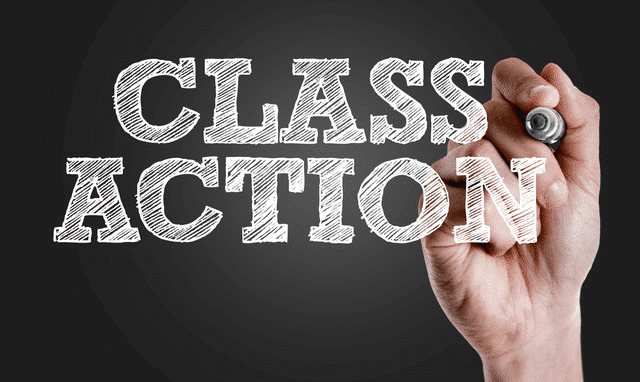Assertio Class Action Lawsuit Breakdown: Your Legal Companion
Wiki Article
Taking Lawful Activity: Understanding Into Class Action Claims
Course activity lawsuits are a powerful tool that enables individuals with comparable grievances to look for and sign up with pressures justice versus an usual offender. These legal actions have acquired significant interest and have the prospective to effect many people, making them a subject of passion for numerous. Recognizing the details of class action lawsuits is important for any individual thinking about taking lawsuit, as it includes different aspects such as benefits, difficulties, and the steps associated with initiating such a suit. In this discussion, we will certainly discover the understanding into class activity legal actions, clarifying the variables that people ought to consider prior to signing up with one.Comprehending Class Activity Suits
Class activity suits are a lawful system that enables a team of people with similar claims versus a defendant to jointly seek settlement or other legal remedies. BioVie class action lawsuit. When a big number of individuals have been impacted by the very same harm or misdeed, this type of claim is commonly utilized. As opposed to each individual bringing a separate legal action, a class action lawsuit allows all influenced parties to combine their insurance claims right into a single legal actionOne key benefit of course activity suits is that they offer access to justice for individuals who may not have the sources or expertise to seek their claims separately. By joining forces with others who have comparable complaints, plaintiffs can merge their resources and increase their possibilities of success. Additionally, course activity legal actions advertise performance by enhancing the lawful procedure and preventing multiple identical suits from blocking up the courts.
To start a class action suit, several people must act as class representatives and file a complaint in support of the whole course. The court after that determines whether the lawsuit fulfills the needs for course qualification, consisting of the complying with requirements: numerosity (an adequately multitude of complainants), commonness (typical concerns of legislation or fact), typicality (the claims of the course agents are regular of the course), and adequacy of representation (the course reps will sufficiently represent the interests of the course) If the court accredits the course, it will alert possible course members that can after that pick to get involved or opt-out.
Benefits of Seeking a Course Action Legal Action
Going after a course activity suit offers people the opportunity to jointly seek settlement or legal remedies for common complaints against an offender. This sort of lawful action gives a number of advantages to complainants, making it an appealing choice in certain circumstances.Among the main benefits of going after a course action legal action is the ability to swimming pool resources and share the prices associated with lawsuits. Lawful procedures can be pricey, involving charges for attorneys, expert witnesses, and court-related expenditures. By joining pressures with various other individuals that have comparable claims, complainants can share these costs and minimize the economic concern on each person.
In addition, class activity legal actions promote effectiveness in the lawful system. As opposed to numerous people submitting separate legal actions versus the same offender, a class action legal action consolidates these insurance claims right into one instance. This not just saves time and resources for the court however likewise simplifies the process for the plaintiffs.
Moreover, course activity lawsuits give a platform for individuals to have their voices heard. By joining with each other, complainants can intensify their complaints and increase the likelihood of accomplishing a desirable outcome. Archer-Daniels-Midland class action lawsuit. This collective strength can also tax defendants to address the underlying concerns and make essential modifications to avoid comparable damage in the future
Difficulties in Class Activity Litigation
One of the crucial considerations in class action lawsuits is the complexity of taking care of a huge team of complainants with diverse rate of interests and situations. This provides a number of challenges that can make the procedure extra hard and taxing. One difficulty is the difficulty of providing and obtaining proof that supports the cases of all the complainants. Each private plaintiff might have various evidence to sustain their situation, and it can be challenging to collect and offer this proof in a cohesive and influential fashion.Another challenge is BioVie class action lawsuit the possibility for conflicts of passion among the complainants. Course action legal actions frequently involve a large number of individuals who might have various objectives and concerns. Some plaintiffs may be mostly thinking about obtaining financial compensation, while others may be much more concentrated on achieving a modification in company habits or obtaining injunctive relief. Balancing these diverse interests can be a significant obstacle for attorneys standing for the course.
Furthermore, there may be challenges in regards to determining the appropriate quantity of problems to be awarded. In class action legal actions, damages are typically granted based upon the ordinary harm endured by the whole class. However, determining this average harm can be intricate, as it needs establishing the level of harm experienced by each specific complainant and accumulating these damages.
Steps to Launch a Course Action Lawsuit
To initiate a course activity claim, the initial step is to determine a valid legal case that impacts a team of individuals who have actually suffered comparable damage or injury. This claim needs to be based on an offense of a legal obligation, such as negligence, fraud, or violation of agreement. Once the case has been recognized, the next step is to collect evidence to sustain the claim. This might entail gathering records, conducting meetings, and consulting experts in the relevant area.
After collecting the essential evidence, the next step is to locate a depictive plaintiff, also called the course rep, who will act on behalf of the whole course. The course rep should have a strong claim and want to birth the obligation of representing the rate of interests of the entire course.
When the depictive plaintiff has been recognized, the next step is to file a grievance with the court. The problem must consist of a comprehensive description of the claims, the damage suffered by the class members, and the alleviation looked for. It is very important to follow all step-by-step needs and target dates established by the court.
After the issue has been filed, the court will review it and determine whether the case can continue as a class activity. The court will certainly think about aspects such as the size of the class, the typical legal issues, and the competence of the representative plaintiff. If the court approves the course activity, it will notify the course participants and permit them to opt-out if they desire to seek their own individual claims.
Variables to Take Into Consideration Prior To Joining a Course Activity Lawsuit
Before deciding to join a course activity suit, individuals need to very carefully assess several variables to figure out if it is the best course of activity for them. While class activity suits can provide a possibility for individuals to seek justice and payment for harm created by a typical entity or product, there are specific considerations that need to be taken into consideration.One factor to take into consideration is the stamina of the instance. It is necessary to evaluate the advantages of the lawsuit and establish if there suffices proof to support the insurance claims being made. This involves examining the lawful disagreements, collecting relevant truths, and speaking with lawyers to determine the chances of success.
One more vital factor is the prospective recovery. If the suit is effective, people should examine the possible financial payment they might receive. This can entail approximating the damages suffered and thinking about the expenses and time associated with seeking the lawsuit.
Additionally, individuals ought to think about the possible threats and downsides of signing up with a course activity legal action. This can consist of the opportunity of a lengthy legal process, the uncertainty of the outcome, and the potential for limited control over the proceedings.
Finally, individuals ought to likewise examine their personal situations and top priorities. Variables such as funds, time dedication, and psychological toll must be taken into consideration prior to determining to sign up with a course action claim.

Verdict
To conclude, class activity claims supply people with the possibility to look for justice and settlement for injury triggered by an usual offender. While they supply advantages such as performance and cost-effectiveness, obstacles such as intricate lawsuits treatments and prospective problems of rate of interest require to be thought about. Prior to joining a class action lawsuit, individuals should carefully weigh the variables and talk to lawyers to make a notified decision.
In course action lawsuits, problems are usually awarded based on the ordinary damage experienced by the entire course (Future FinTech class action lawsuit). If the court approves the class activity, it will alert the class members and allow them to opt-out if they desire to seek their own individual cases
Report this wiki page